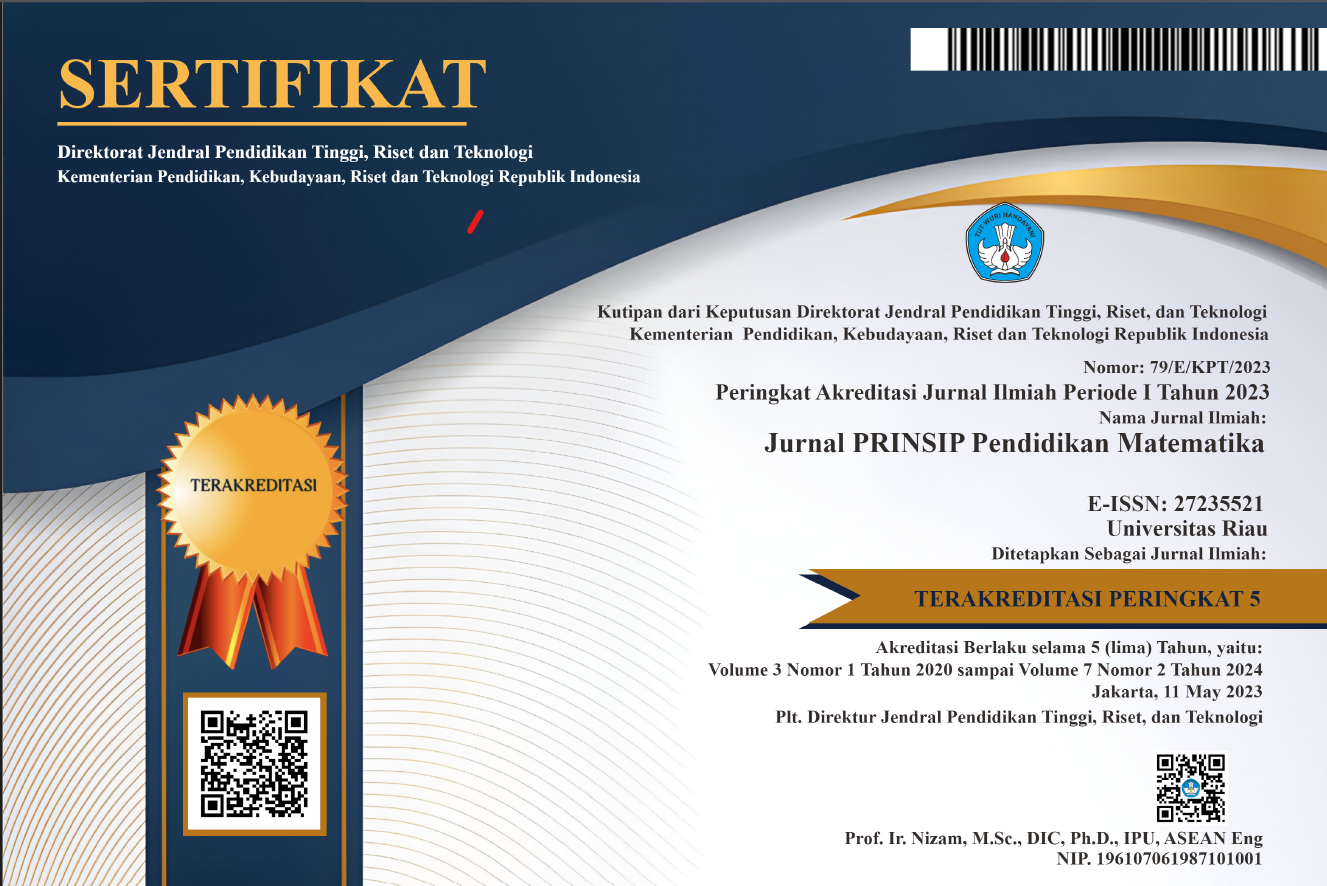ANALYSIS OF STUDENT ERRORS IN SOLVING THE SYSTEM OF THREE VARIABLE LINEAR EQUATIONS (SPLTV) BASED ON THE NEWMAN STAGES IN CLASS X STUDENTS AT UPT SMA NEGERI 1 PAREPARE
Abstract
This study aims to describe the location of errors and the causes of student errors in solving the problems of the Three Variable Linear Equation System in Contextual Problems (daily life) using the Determinant Matrix Method. This material was chosen because students often make many mistakes when solving problems. This type of research is descriptive research with a qualitative approach. The subjects of this study were six students who were taken from the results of consultations with the Mathematics teacher of UPT SMA Negeri 1 Parepare. The data collection technique is a written test with three questions. . Based on the results of the study, it was concluded that students' errors in solving the problems of the Three-variable Linear Equation System in Contextual Problems (Daily Life) used the Determinant Matrix Method, namely First, the Reading Error was 13%. This is caused because students are less thorough and in a hurry to dig up the information, so the mistakes made by these students are fatal. Second, Comprehension Error is as much as 16%. This is caused because students do not write down information about what is known and asked and the information written is not appropriate. Third, a Transformation Error of 23% is caused because students cannot identify the right operation to solve the given problem. Students write the wrong sign in the arithmetic operation of the problem. Fourth, Process Kill is 19%, this is caused because students cannot carry out the calculation operation process correctly. And Fifth, Encoding Error of as much as 29% is caused because students are wrong in writing the final answer and do not write conclusions from the questions given.
Downloads
References
Abdullah, A. H., Abidin, N. L. Z., & Ali, M. (2015). Analysis of students’ errors in solving Higher Order Thinking Skills (HOTS) problems for the topic of fraction. Asian Social Science, 11(21), 133–142. https://doi.org/10.5539/ass.v11n21p133
Darmawan, I., Kharismawati, A., Hendriana, H., & Purwasih, R. (2018). Analisis kesalahan siswa SMP berdasarkan Newman dalam menyelesaikan soal kemampuan berfikir kritis matematis pada materi Bangun Ruang Sisi Datar. Juring (Journal for Research in Mathematics Learning), 1(1), 71–78. https://doi.org/http://dx.doi.org/10.24014/juring.v1i1.4912
Dewi, S. P., & Kartini, K. (2021). Analisis Kesalahan siswa dalam menyelesaikan soal Sistem Persamaan Linear Tiga Variabel berdasarkan prosedur kesalahan Newman. Jurnal Cendekia : Jurnal Pendidikan Matematika, 5(1), 632–642. https://doi.org/10.31004/cendekia.v5i1.508
Fatahillah, A., Wati, Y. F., & Susanto. (2017). Analisis kesalahan siswa dalam menyelesaikan soal cerita matematika berdasarkan tahapan newman beserta bentuk scaffolding yang diberikan. Jurnal Kadikma, 8(1), 40–51.
Hidayanto, T., Subanji, & Hidayanto, E. (2017). Deskripsi kesalahan struktur berpikir siswa SMP dalam menyelesaikan masalah Geometri serta defragmentingnya: Suatu Studi Kasus. Jurnal Kajian Pembelajaran Matematika, 1(1), 72–81.
Ma’rifah, C., Sa’dijah, C., Subanji, S., & Nusantara, T. (2020). Profil kemampuan komunikasi matematis peserta didik dalam pemecahan masalah soal cerita. Edu Sains Jurnal Pendidikan Sains & Matematika, 8(2), 43–56. https://doi.org/10.23971/eds.v8i2.1991
Murtiyasa, B., & Wulandari, V. (2020). Analisis kesalahan siswa materi Bilangan Pecahan berdasarkan teori Newman. AKSIOMA: Jurnal Program Studi Pendidikan Matematika, 9(3), 713. https://doi.org/10.24127/ajpm.v9i3.2795
Siregar, H. M. (2019). Analisis kesalahan siswa dalam menyelesaikan soal tes kemampuan berpikir kreatif matematis materi lingkaran. AKSIOMA: Jurnal Program Studi Pendidikan Matematika, 8(3), 497–507. https://doi.org/10.24127/ajpm.v8i3.2379
Siregar, H. M., & Solfitri, T. (2019). An analysis of students’ errors in solving Indefinite Integral problems viewed from gender differences. Journal of Research on Mathematics Instruction (JRMI), 1(1), 17–24. https://doi.org/10.33578/jrmi.v1i1.12
Solfitri, T., Kartini, Siregar, H. M., & Syari, R. (2019). The analysis of students’ errors in using Integration Techniques. Proceeding of the SS9 & 3rd URICES, 2019, Pekanbaru, Indonesia, 328–335.
Solfitri, T., & Siregar, H. M. (2021). Developing integration techniques module to improve mathematical creative thinking ability in Integral Calculus. Jurnal PAJAR (Pendidikan Dan Pengajaran), 5(2), 296–305. https://doi.org/http://dx.doi.org/10.33578/pjr.v5i2.8221
Suyitno, A. (2015). Learning therapy for students in mathematics communication correctly based-on application of Newman procedure (A case of Indonesian students). International Journal of Education and Research, 3(1), 529–538.
Wahidah, Y. N., Inganah, S., & Ismail, A. D. (2017). The analysis of mathematical problems using Newman stages reviewed from emotional intelligence. Mathematics Education Journal, 1(2), 56–62. https://doi.org/10.22219/mej.v1i2.4630
Copyright (c) 2022 Jurnal Prinsip Pendidikan Matematika

This work is licensed under a Creative Commons Attribution-NonCommercial-ShareAlike 4.0 International License.





